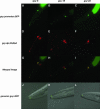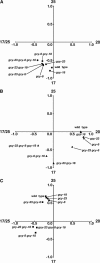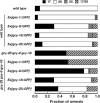Identification of guanylyl cyclases that function in thermosensory neurons of Caenorhabditis elegans
- PMID: 16415369
- PMCID: PMC1456394
- DOI: 10.1534/genetics.105.050013
Identification of guanylyl cyclases that function in thermosensory neurons of Caenorhabditis elegans
Abstract
The nematode Caenorhabditis elegans senses temperature primarily via the AFD thermosensory neurons in the head. The response to temperature can be observed as a behavior called thermotaxis on thermal gradients. It has been shown that a cyclic nucleotide-gated ion channel (CNG channel) plays a critical role in thermosensation in AFD. To further identify the thermosensory mechanisms in AFD, we attempted to identify components that function upstream of the CNG channel by a reverse genetic approach. Genetic and behavioral analyses showed that three members of a subfamily of gcy genes (gcy-8, gcy-18, and gcy-23) encoding guanylyl cyclases were essential for thermotaxis in C. elegans. Promoters of each gene drove reporter gene expression exclusively in the AFD neurons and, moreover, tagged proteins were localized to the sensory endings of AFD. Single mutants of each gcy gene showed almost normal thermotaxis. However, animals carrying double and triple mutations in these genes showed defective thermotaxis behavior. The abnormal phenotype of the gcy triple mutants was rescued by expression of any one of the three GCY proteins in the AFD neurons. These results suggest that three guanylyl cyclases function redundantly in the AFD neurons to mediate thermosensation by C. elegans.
Figures









References
Publication types
MeSH terms
Substances
Associated data
- Actions
- Actions
- Actions
Grants and funding
LinkOut - more resources
Full Text Sources
Molecular Biology Databases

